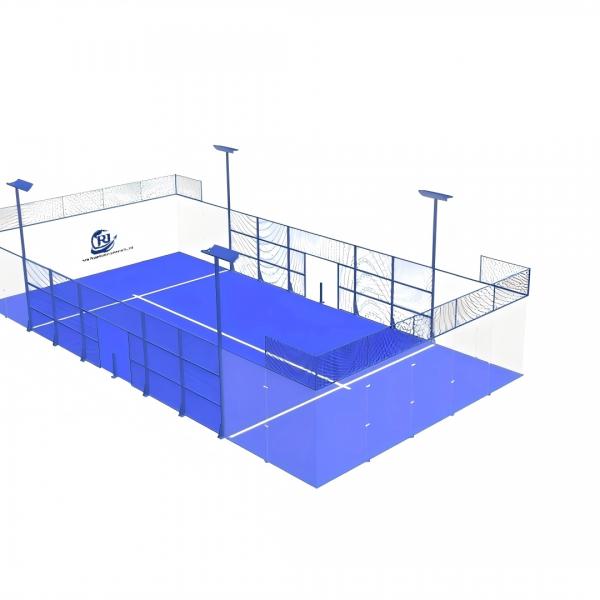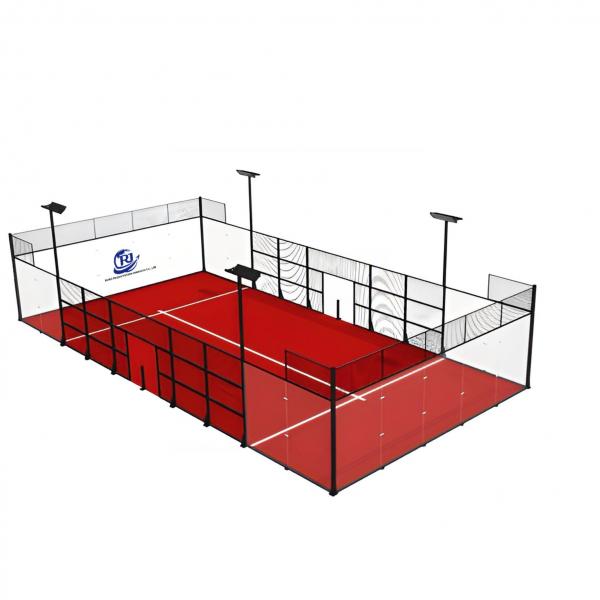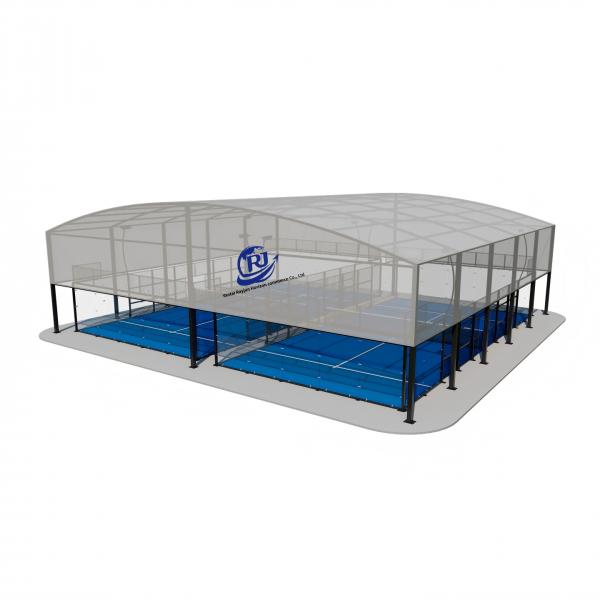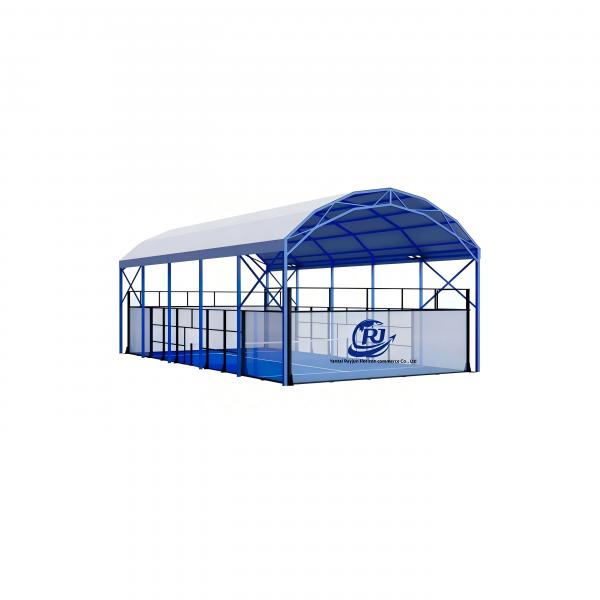Evaluating the quality of padel court glass requires a systematic check across standards compliance, physical performance, structural safety, and practical durability—since padel glass is subjected to repeated ball impacts, weather exposure, and mechanical stress. Below Rayjunsports give you an step-by-step framework to assess its quality, tailored to the unique demands of padel courts:
1. First: Verify Compliance with Core Standards
Padel glass must adhere to safety and performance standards (regional or international) to ensure it meets minimum requirements. This is the foundational check:
European Markets: Mandatory compliance with EN 12150-1:2021 (Thermally Toughened Soda-Lime Silicate Safety Glass). This standard guarantees:
Minimum surface stress (≥90 MPa) for impact resistance.
Fragmentation control (40–400 small, harmless pieces per 50mm×50mm area when broken, preventing large, sharp shards).
Dimensional tolerances (e.g., thickness variation ≤±0.2mm for nominal thicknesses <12mm) and flatness (bow/warp limits to avoid frame misalignment).
Other Regions:
USA: ASTM C1048 (Standard Specification for Heat-Treated Flat Glass) for tempered glass.
Asia: ISO 12543 (Glass in building – Thermally toughened soda-lime silicate glass) or local equivalents (e.g., China GB 15763.2).
Padel-Specific Guidelines: Some regional padel associations (e.g., the International Padel Federation, FIP) or national bodies (e.g., Spain’s RFEPA) issue supplementary specs (e.g., minimum glass thickness: typically 10mm or 12mm for padel courts). Confirm the glass meets these.
2. Assess Physical & Mechanical Performance (Critical for Padel Use)
Padel balls hit glass walls at high speeds (up to 120 km/h) repeatedly—so the glass must withstand impact without cracking or degrading. Focus on these key properties:
A. Thickness & Material Grade
Minimum Thickness: Padel courts require 10mm or 12mm tempered glass (12mm is preferred for high-traffic or professional courts). Thinner glass (e.g., 8mm) may fail under repeated impacts.
Material Purity: Ensure it is soda-lime silicate glass (the standard for tempered safety glass). Avoid low-grade glass with impurities (e.g., bubbles, inclusions) that weaken structural integrity.
B. Impact Resistance
Test Compliance: Ask the supplier for test reports proving the glass passes EN 12150-1’s impact test (a 227g steel ball dropped from 2 meters onto the glass surface; no breakage = pass). For padel, some courts require stricter testing (e.g., simulating 10,000+ ball impacts at padel-specific speeds).
Edge Strength: Padel glass edges are vulnerable to stress (e.g., from frame pressure or accidental knocks). Check that edges are machine-ground and chamfered (per EN 12150-1) to remove sharpness and reduce micro-cracks—unfinished edges are prone to chipping or breaking.
C. Fragmentation (Safety Check)
If possible (via supplier test data), confirm that broken glass fragments meet EN 12150-1’s requirements:
No single fragment has a sharp edge longer than 75mm.
No fragment has a surface area >3 cm² (to avoid severe injury).
For 10–12mm glass, 30–40 fragments per 50mm×50mm area are acceptable.
3. Check Optical Clarity (Affects Gameplay)
Poor optical quality distorts players’ vision (e.g., making the ball appear blurry or misaligned). Evaluate:
Transmittance: High-quality padel glass has ≥85% light transmittance (per EN 410 for building glass). Low transmittance (e.g., <80%) darkens the court and impairs visibility.
Distortion: Stand 3–5 meters from the glass and look at a straight line (e.g., a doorframe or ruler) through it. There should be no visible bending, waviness, or "ripples"—these indicate uneven glass thickness or poor tempering.
Surface Defects: Inspect for scratches, pits, or bubbles (visible to the naked eye at arm’s length). EN 12150-1 allows minor defects, but any that affect vision (e.g., scratches >0.5mm wide) are unacceptable.
4. Evaluate Weather & Environmental Durability
Padel courts (indoor or outdoor with canopies) are exposed to:
UV Radiation: Outdoor/canopied courts need glass with UV protection coating (e.g., a SiO₂-based layer) to prevent yellowing, surface degradation, or loss of clarity over time (5–10 years). Ask for UV resistance test data (e.g., no color change after 1,000 hours of UV exposure).
Temperature Resistance: Tempered glass (per EN 12150-1) should withstand thermal shock (e.g., sudden temperature changes from -20°C to 60°C) without cracking. This is critical for outdoor courts in extreme climates.
Moisture & Corrosion: For glass edges (or silicone seals), ensure no signs of water infiltration or rust (if metal spacers are used). Moisture can weaken the glass-frame bond over time.
5. Inspect Installation & Structural Compatibility
Even high-quality glass fails if installed poorly. Check:
Frame Fit: The glass should sit snugly in the aluminum/steel frame without gaps (>2mm gaps allow movement and stress). The frame should be level and square (use a laser level to verify).
Sealant Quality: Silicone sealants (used to fix glass to the frame) must be weather-resistant and compatible with tempered glass (e.g., neutral-cure silicone, not acidic silicone, which can corrode glass edges). Seals should be uniform (no gaps or cracks) to prevent water/dust ingress.
Load Capacity: The glass should be rated to withstand additional loads (e.g., wind pressure for outdoor courts, or accidental impacts from players leaning on it). Ask for structural calculations (e.g., wind load resistance ≥1.5 kPa).
6. Verify Traceability & Quality Certifications
Reputable suppliers provide documentation to prove quality. Request:
Certificate of Compliance (CoC): Issued by the manufacturer, confirming the glass meets EN 12150-1:2021 (or regional equivalents) and padel-specific specs.
Test Reports: From third-party labs (e.g., SGS, TÜV) for impact resistance, fragmentation, and optical clarity.
Markings: Tempered glass must be permanently marked (per EN 12150-1) with:
Manufacturer’s logo or code.
Standard number (e.g., "EN 12150-1:2021").
Glass thickness (e.g., "12mm").
Batch number (for traceability if defects occur).
7. Practical Field Tests (Post-Installation)
After installation, conduct on-site checks:
Impact Test (Non-Destructive): Use a padel ball to hit the glass at different points (center, edges) with moderate force. The glass should vibrate slightly but not crack or make unusual noises (e.g., creaking, which indicates frame stress).
Leak Check (Outdoor/Canopied Courts): Simulate rain with a hose. No water should seep through the frame-seal interface or into the court.
Vision Test: Have a player stand on the court and hit balls against the glass. Confirm no vision distortion affects their ability to track the ball.
Summary of Key Red Flags to Avoid
No compliance with EN 12150-1/ASTM C1048.
Thickness <10mm (for recreational courts) or <12mm (for professional use).
Visible distortion, scratches, or bubbles.
Lack of third-party test reports or traceable markings.
Poorly fitted frames or low-quality sealants.
By following this framework, you can ensure padel glass meets safety, performance, and gameplay standards for long-term use.








